Feminism is often perceived as an attack on traditional values and in opposition to family life. New Domesticity: Women’s Work in Women’s Art, the current show at the Parachute Factory and the Morlan Gallery, investigates how people identify with societal notions of womanhood, and highlights the malleability of this concept as a whole.
According to the curator, Emily Elizabeth Goodman, “these domestic works…explore where we have been, calling on the work of women ancestors to illuminate the present by considering the past.†Right now, change is occurring rapidly in how society considers concepts such as gender, family, and femininity in particular; but works like these remind us that the past is not actually past.
Institutional ideologies only last because people fail to question them; thus it is essential to consider how history continues to inform contemporaneity. Now more than ever it is important to think critically about one’s perceived place in society and how gender may come to inform conceptions of identity.
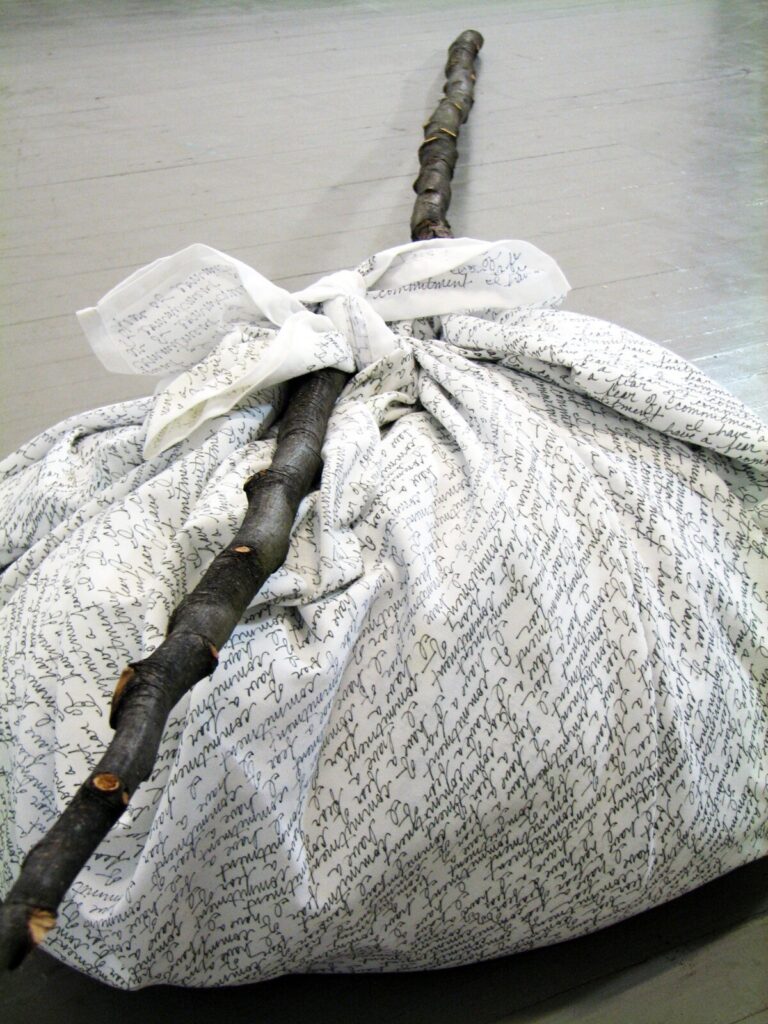
Some of the most particularly memorable works in the exhibition are by Lexington artist Stacey Chinn, “Bindle (I have a Fear of Commitment)â€, 2013, and “Bindle (Mother May I?)â€, 2017. The former is a nine and a half foot tall tree branch and a tied bed sheet with polyester fiberfill, leaning on an angle against the wall. Ink handwriting fills the entirety of the white sheet with the phrase repeated over and over, “I have a fear of commitment.â€
Both of these works reference the cultural conceptions of womanhood in a context of the masculine vagabond. The use of the bed sheet in “Bindle (I have a Fear of Commitment)†references domestic labor that women are traditionally expected to commit to, such as making the bed. The bindle itself evokes feelings of rebellion and freedom from conventional norms.
The size of this piece makes it stand out across the gallery, but the juxtaposition between the coarse tree branch and delicate bed sheet adds another dimension to the statement on feminine freedom. Even the act of putting ink on the bed sheet can be symbolic for rebellion against the commitment to traditional house labor. This piece asks how one defines femininity in the presence of a desire for freedom and an absence of a “natural†domestic instinct.
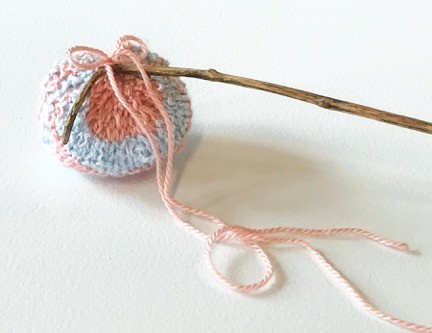
“Bindle (Mother May I?)â€, made from a thin stick and knitted pouch, references gender as well as motherhood in particular. It is a much smaller version of the previous bindle, a little longer than a forearm, and notably uses a combination of pink and blue knit. In comparison to the size of the “Bindle (I have a Fear of Commitment)â€, this one reads as a child’s toy, and the knit material mimics handmade baby’s clothes. The combination of these formal decisions disrupts cultural conceptions concerning freedom by revealing the masculinity tied to vagabonds, and using it as a platform to consider freedom abstractly.
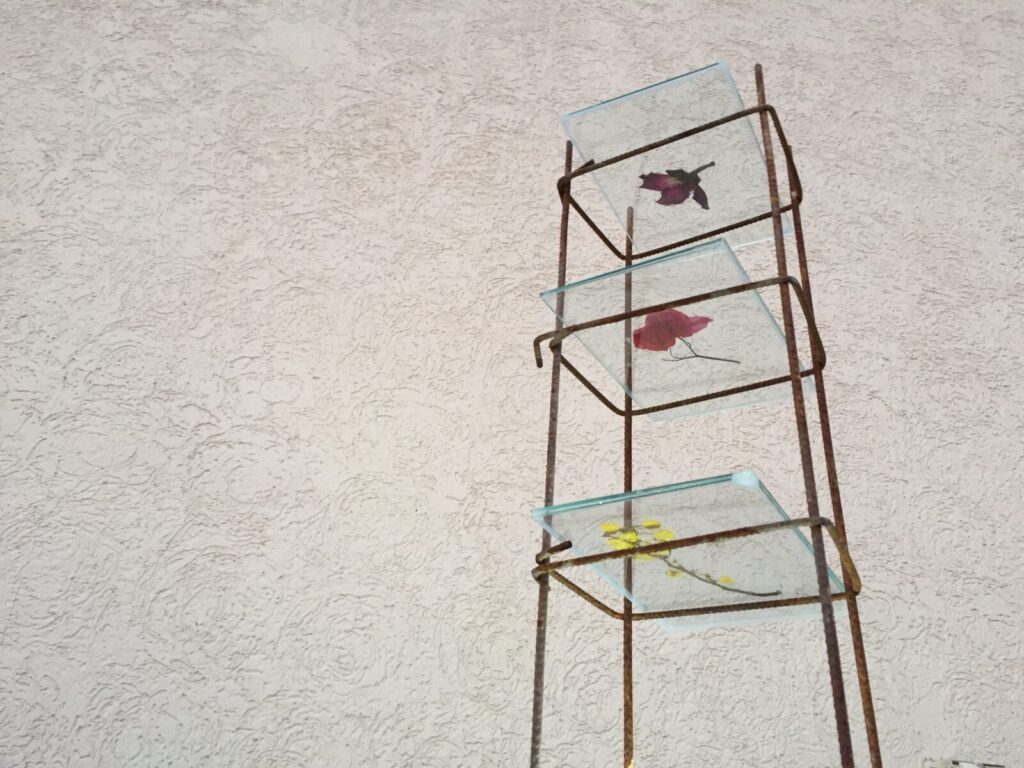
Another interesting idea of domesticity is depicted in Stacey Reason’s “Lomas Towerâ€, 2015. From Paducah Kentucky, her sculpture was partly inspired by her time spent living in Mexico in a “European style†housing development, which was culturally cut off from the community around it. The sculpture is comprised of steel, glass, press flowers, caulk, concrete, a light socket, a LED light bulb, and paper. From a side view the sculpture appears minimal and industrial. Yet, when viewed from the bottom up, a succession of pressed flowers illuminated by light at the bottom creates a natural yet sterilized aesthetic.
“Lomas Tower†engages with domesticity by calling attention to new types of domestic spaces and how traditional ideas translate. By calling attention to the form and function of these kinds of housing developments, Reason identifies the highly constructed lifestyle they perpetuate. In addition to questions of domesticity, Reason’s work discusses issues of class as well as industrialism.
The materials in the sculpture are the same ones used in her own housing development. Using cheap materials while also perpetuating a modern lifestyle; these housing developments are indicative of deeply rooted impacts of industrialism on modern home life.
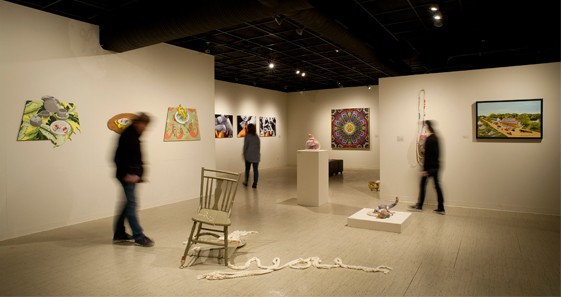
New Domesticity: Women’s Work in Women’s Art, on view through February 16th at the Morlan Gallery and through Feburary 24th at the Parachute Factory, makes a uniquely essential point about current cultural conditions. Ideas about gender roles and femininity are being questioned in society, no doubt; but this show also makes the point that conceptions of femininity are not only fluid in terms of time, but also varied from one perspective to the next.
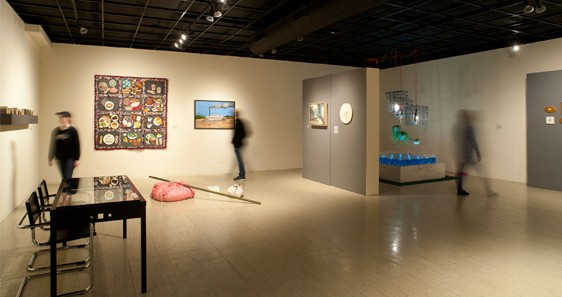
The emphasis on diversity in age, race, and geographic location in this show provides a broad platform with which to further consider contemporary womanhood and find common ground among the obstacles, which usually keep us apart. The show is described by the curator as “a criticism of the fictional naturalness of the affinity between domesticity and womanhood,†but along those lines, it mimics the female empowerment movement in society today.
New Domesticity uplifts female artists, and simultaneously critiques the institutional ideas that have historically limited woman’s power, while celebrating the present condition of women by evoking the past.
This exhibition also features the work of Jane Burch Cochran, Rae Goodwin, Judith Pointer-Jia, Diane Kahlo, Helen LaFrance, Lori Larusso, Colleen Merrill, Stacey Reason, Jennifer A. Reis, Kristin Richards, Justine Riley, Bianca Lynne Spriggs, Bentley Utgaard and L.A. Watson is accompanied by this 51-page catalogue.
About the author: Savannah Wills is a Chellgren Scholar at the University of Kentucky. She is seeking art history and art administration degrees and has chosen to work with UnderMain as her spring project. Christine Huskisson has committed to guiding her as she embraces the concept of criticism in both writing and by assisting UnderMain in organizing our second panel discussion on the topic: “Critical Mass II: The Value of Critical Discourse in the Arts - A Discussion on Authority and Accessibility in the Written Review†to be held on Wednesday, March 28th, 2018 in Louisville, Kentucky in partnership with the KMAC Museum and The Great Meadows Foundation. Watch for the UnderMain Newsletter on February 26th for final details and welcome aboard Savannah!Â




